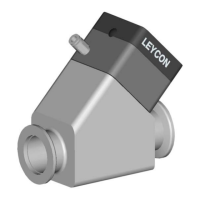
Do you have a question about the LEYBOLD LEYCON BAV P AL Series and is the answer not in the manual?
| Brand | LEYBOLD |
|---|---|
| Model | LEYCON BAV P AL Series |
| Category | Control Unit |
| Language | English |
Highlights critical statements requiring special attention, often related to safety or critical operations.
Details how to identify the product using fabrication and part numbers on the nameplate.
Specifies which part numbers are covered by this document and applicable to its content.
Provides detailed specifications including materials, dimensions, switching times, weight, and electrical ratings.
Lists all items included with the valve, such as connectors and protective covers.
Outlines Leybold's liability disclaimer and conditions under which the warranty is voided or claims may be refused.
Emphasizes the necessity of reading and understanding this chapter for personal safety.
Defines hazard symbols (DANGER, WARNING, CAUTION, NOTICE) and their associated risk levels for safe operation.
Defines the intended applications for the high vacuum valves and specifies permitted and adverse uses.
Clarifies the responsibilities of the manufacturer and the operator regarding product usage and safety.
Stresses that only qualified personnel should perform work on the product to prevent injury or damage.
Provides general guidelines for safe handling, considering process media and potential contaminations.
Describes the warning labels found on the product and their corresponding part numbers.
Illustrates the internal components and overall structure of the angle valve (NC model).
Explains the operating principle of the valves, distinguishing between NC (normally closed) and NO (normally open) models.
Provides guidance on checking for transport damage, verifying completeness, and proper storage of packaging material.
Details critical safety warnings regarding overpressure in vacuum systems and proper clamp usage.
Offers a caution for connecting compressed air, emphasizing system installation and safe practices.
Includes safety warnings for electric shock and wrong voltage, along with steps for connecting power.
Describes the standard functioning of the valve, typically closed by a spring and opened pneumatically.
Refers to chapter 1.4 Technical Data for specific operating conditions at higher temperatures.
Explains how the valve functions when compressed air supply is lost (remains closed or closes by spring).
Details the valve's response to a power failure, typically closing leaktight by a spring.
Describes the specific operating characteristics of the normally open (NO) valve variant.
Details the process for replacing vacuum seals, including dismounting and mounting of the actuator assembly.
Provides step-by-step instructions for safely dismounting the valve from the system, including cooling and power disconnection.
Specifies conditions for proper storage, including temperature, humidity, and protection from contamination.
Guides on closing valve openings, using original packaging material, and ensuring the valve is closed during packing.
Warns against inappropriate packaging and handling, advising the use of suitable means and original materials.
Outlines responsibilities for health and safety, informing contractors about component contamination for repair work.
Provides a form to declare chemical contact with equipment, required for repair or servicing.
An EC declaration confirming the product complies with relevant EU machinery and low voltage directives.
